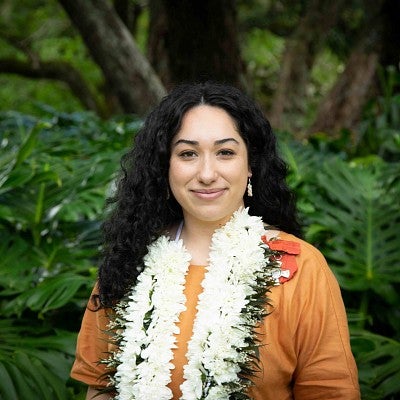
January 23, 2024 - 3:00pm
After a three-year labor of love and a long-standing desire to give a voice to Pacific artists, a 544-page compilation of art, stories, culture, and history is hitting the shelves with Pacific Arts Aotearoa. Edited by Lana Lopesi, assistant professor in the College of Arts and Sciences, the book shows a mosaic of narratives that delve into the complex and unique history of Aotearoa New Zealand.
This project began in 2020, at the start of the COVID-19 pandemic. Makerita Urale from Creative New Zealand, the national arts funding body, approached Lopesi to create a project in response to the challenges faced by artists during lockdowns.
“She reached out to me, and we did some brainstorming,” Lopesi said. “It started as an online project in response to artists losing their work and being locked down. It seemed like a great opportunity to capture some important art histories.”

At the start, the team commissioned 10 artists to write their stories for the Pacific Arts Aotearoa. This number began multiplied to 20 artists, then 40. Now in its entirety, the book holds 12 chapters in total with 120 additional contributions written by artists, curators, and researchers.
This work was initially launched as an online project focusing on telling the stories of Pacific art using the voices of Pasifika artists. Pasifika people is used to refer to the people, cultures and languages of the Pacific groups. Pacific Arts Aotearoa serves as the first comprehensive history of Pacific arts in Aotearoa New Zealand with a span of over six decades of art.
When the online project launched, Penguin Random House reached out to the team to help them develop a book version. The book, first published in New Zealand in October 2023, is soon to be released in the US this spring.
"Usually, art history is written from an individual’s perspective,” Lopesi said. “What’s unique about this book is that it includes the artists' voices themselves. With this diversity of voices and perspectives, you get a truer understanding of the range and complexity of the voices presented."
The book contains archival images, original photography, stories, poems, and illustrations, with every piece of media held together by a narrative story that spans the 12 chapters.
"Putting a book together of this scale is different from an online project, which can be infinite and isn’t limited in the same way that books are by page numbers and word counts," explained Lopesi. "We had to think about the scope and the scale of the book project and it took a significant amount of time."
The selection process for the featured works and artists was a delicate task, aiming to include as many voices as possible. The book encompasses early trailblazers, contemporary leaders, and emerging talents, ensuring a representation of diverse art forms and reflecting the broad spectrum of the Pacific.
Alongside Lopesi and Urale, this project was supported by several others. The Penguin and Creative New Zealand teams were cited as major contributors to making this project possible. Additionally, Tongan designer Shaun Naufahu, who was in charge of the design portion of the book, used Tongan iconography to establish a design and language grid, as well as Samoan editor Faith Wilson, who Lopesi said assisted with every aspect of the book.

“Pacific people are still significantly underrepresented in many spheres of life, and literature is one of those areas. To have a Pacific-led team working with over 120 Pacific voices to tell their stories is significant, I’m hopeful that this work will inspire Pacific people to keep telling their stories and publishers to keep supporting them to do so.”
Lopesi feels honored to have been trusted to care for this project and believes that there is something in it for everyone. This book is more than a compilation. It has become a celebration of resilience and a testament to cultural diversity while calling for more inclusivity of Pacific voices in art and literature.
—By Codi Farmer, College of Arts and Sciences
—Top photo: A photo from Pacific Arts Aotearoa
